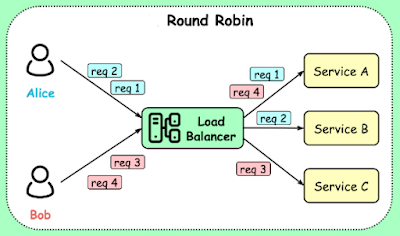Load balancing algorithms are used to determine how incoming network requests should be distributed among a group of servers. The choice of algorithm impacts the efficiency and performance of the load balancer.
Here are some common load-balancing algorithms:
1. Round Robin:
- Requests are distributed sequentially in a circular order to each server in the pool.
- Simple and equal distribution of requests but doesn't consider server performance or load.
2. Least Connections:
- New requests are directed to the server with the fewest active connections.
- Helps distribute traffic more evenly and can prevent overloading a single server.
3. IP Hash:
- A hash function maps the client's IP address to a specific server.
- Ensures that the same client is consistently directed to the same server, crucial for stateful applications.
4. Weighted Round Robin:
- Similar to the round-robin algorithm, each server is assigned a weight to represent its capacity or performance.
- Servers with higher weights receive more traffic.
5. Weighted Least Connections:
- Similar to the least connections algorithm, but takes into account server weights to distribute traffic.
- Combines the benefits of both weighted and least connections approaches.
6. Random:
- Requests are distributed randomly to the servers in the pool.
- Simple, but may not result in even traffic distribution.
7. Content-Based Routing:
- Makes routing decisions based on the content of the request or response, typically used in Layer 7 load balancers.
- Suitable for applications with specific content-based routing requirements.
8. Response Time:
- Monitors the response times of servers and directs new requests to the server with the fastest response time.
- Aims to reduce response times and improve user experience.
9. Least Response Time:
- Similar to the response time algorithm but takes into account the server with the least response time.
- Further optimizes response times but can be sensitive to outliers.
10. Chained Failover:
- Traffic is directed to the first server in a list, and if that server is unavailable, it moves to the next server in the list.
- Provides failover capabilities but may not distribute traffic evenly in normal conditions.
11. Least Bandwidth:
- Routes traffic to the server with the least bandwidth usage.
- Useful for scenarios where bandwidth usage varies significantly between servers.
12. Least Packets:
- Directs traffic to the server with the fewest packets transmitted.
- Can help balance network load based on packet count.
The choice of load balancing algorithm depends on the specific requirements of your application, the type of traffic you're handling, and the characteristics of your server pool. Some algorithms are more suitable for simple round-robin distribution, while others are designed for advanced content-based routing and optimization. It's important to select the algorithm that best meets your application's performance and availability needs.





